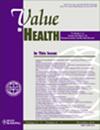Cancer Drug Wastage and Mitigation Methods: A Systematic Review
IF 4.9
2区 医学
Q1 ECONOMICS
引用次数: 0
Abstract
Objectives
To systematically review published evidence on cancer drug wastage and the effectiveness of mitigation methods.
Methods
Search keywords for Scopus, PubMed, and EMBASE were developed using the Pearl Growing technique. Relevant articles were identified in a 2-step process: first, based on titles/abstracts, then on full article reviews. Among the identified English peer-reviewed articles, those considering adults ≥18 years and relevant cancer drug wastage outcomes were included. Key concepts and measures for drug wastage and its mitigation were tabulated. Trends in publication numbers were analyzed using Mann-Kendall tests. Costs were converted first to 2024 local currencies using country-wise consumer price indexes and then to 2024 USD using exchange rates.
Results
Among 6298 unique articles, 94 met the inclusion criteria. Seventy-four (79%) of these were published since 2015, highlighting increasing attention to cancer drug wastage. Twenty-three articles (24%) explicitly reported drug wastage amounts, whereas 52 articles (55%) considered the mitigation methods. Most articles focused on high-income countries (n = 67), single-hospital settings (n = 45), and retrospective study designs (n = 55). Wastage mitigation techniques included vial sharing (n = 21), dose rounding (n = 17), closed-system transfer device (n = 9), centralized drug preparation (n = 7), and vial size optimization (n = 7). A trend toward higher median wastage cost was evident in US settings ($135.35/patient-month) compared with other countries ($37.71/patient-month), whereas mitigation methods across countries were not statistically significant.
Conclusions
High cancer drug costs highlight the importance of minimizing drug wastage to reduce healthcare expenditure. Our review demonstrates that wastage varies by healthcare setting and mitigation technique. Future studies would benefit from reporting standards for cancer drug wastage that include reporting wastage (both in mg and cost, preferably in terms of purchase power parity), as well as cohort size, considered vial sizes, considered dosages, and used mitigation methods separately for each drug. This approach would account for variability in cancer drug wastage and help identify optimal mitigation practices tailored to the health system context.
癌症药物浪费与缓解方法:系统综述。
目的系统回顾已发表的有关抗癌药物浪费和缓解方法有效性的证据:方法:使用珍珠生长技术为 Scopus、PubMed 和 EMBASE 创建搜索关键词。相关文章的确定分为两步:首先是基于标题/摘要,然后是全文综述。在已确定的英文同行评审文章中,纳入了那些考虑到≥18 岁成人和相关癌症药物浪费结果的文章。将药物浪费及其缓解的关键概念和措施制成表格。使用 Mann-Kendall 检验分析了发表文章数量的变化趋势。成本首先使用各国的消费者价格指数换算成 2024 年的当地货币,然后使用汇率换算成 2024 年的美元:在 6298 篇文章中,有 94 篇符合纳入标准。其中74篇(79%)是2015年以来发表的,凸显了人们对抗癌药物浪费问题的日益关注。23篇文章(24%)明确报告了药物浪费的数量,52篇文章(55%)考虑了缓解方法。大多数文章集中在高收入国家(67 篇)、单一医院环境(45 篇)和回顾性研究设计(55 篇)。减少浪费的技术包括药瓶共享(21 篇)、剂量调整(17 篇)、封闭系统转移装置(9 篇)、集中药物制剂(7 篇)和药瓶尺寸优化(7 篇)。与其他国家(37.71美元/患者-月)相比,美国的中位浪费成本(135.35美元/患者-月)有明显升高的趋势,而各国的缓解方法在统计学上并无显著差异:高昂的抗癌药物成本凸显了尽量减少药物浪费以降低医疗支出的重要性。我们的研究表明,浪费情况因医疗环境和缓解技术而异。未来的研究将受益于抗癌药物浪费的报告标准,包括报告浪费量(毫克和成本,最好以购买力平价表示)、队列规模、考虑的药瓶大小、考虑的剂量以及针对每种药物分别采用的缓解方法。这种方法将考虑到抗癌药物损耗的差异性,并有助于确定适合卫生系统情况的最佳缓解做法。
本文章由计算机程序翻译,如有差异,请以英文原文为准。
求助全文
约1分钟内获得全文
求助全文
来源期刊

Value in Health
医学-卫生保健
CiteScore
6.90
自引率
6.70%
发文量
3064
审稿时长
3-8 weeks
期刊介绍:
Value in Health contains original research articles for pharmacoeconomics, health economics, and outcomes research (clinical, economic, and patient-reported outcomes/preference-based research), as well as conceptual and health policy articles that provide valuable information for health care decision-makers as well as the research community. As the official journal of ISPOR, Value in Health provides a forum for researchers, as well as health care decision-makers to translate outcomes research into health care decisions.
 求助内容:
求助内容: 应助结果提醒方式:
应助结果提醒方式:


